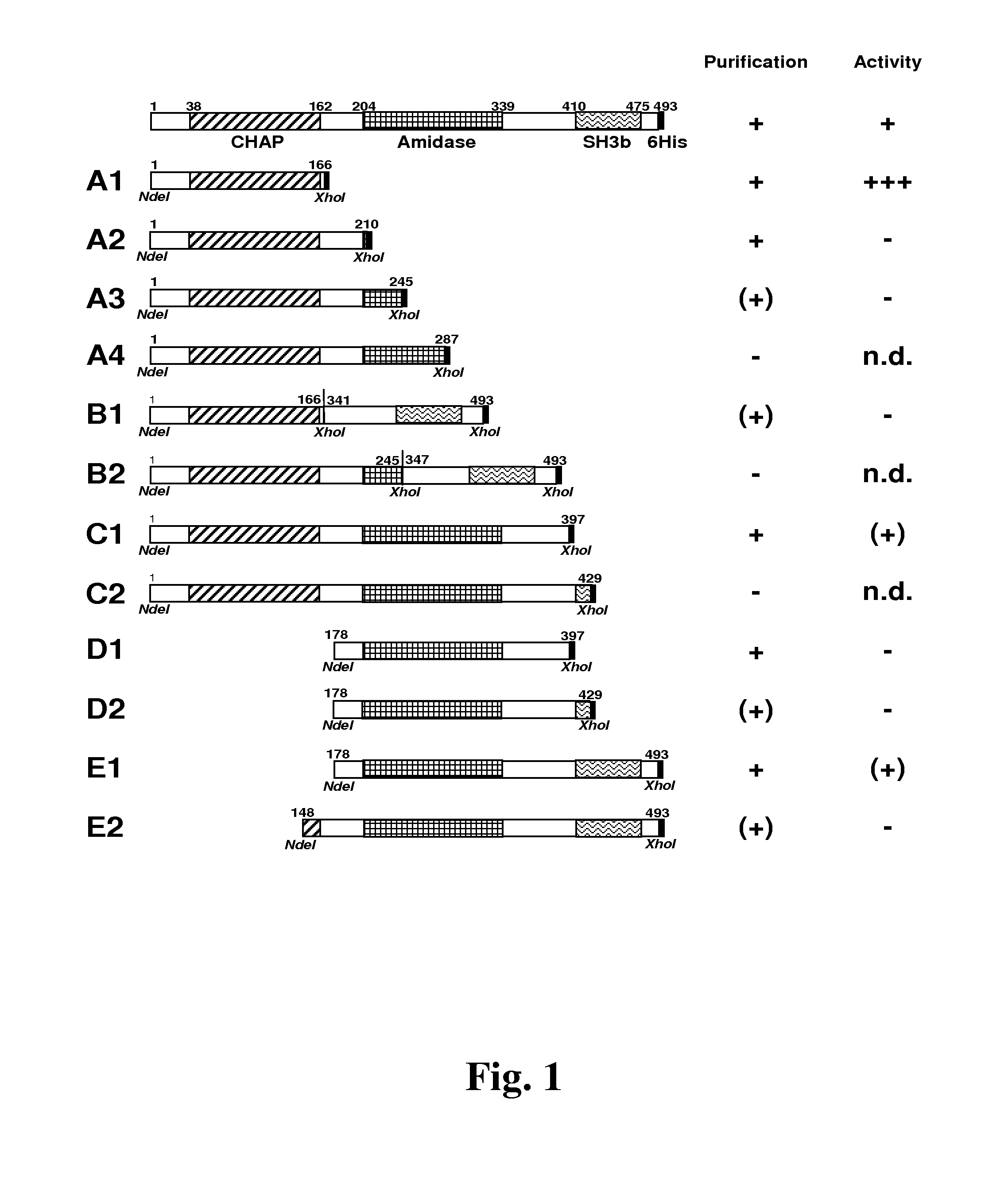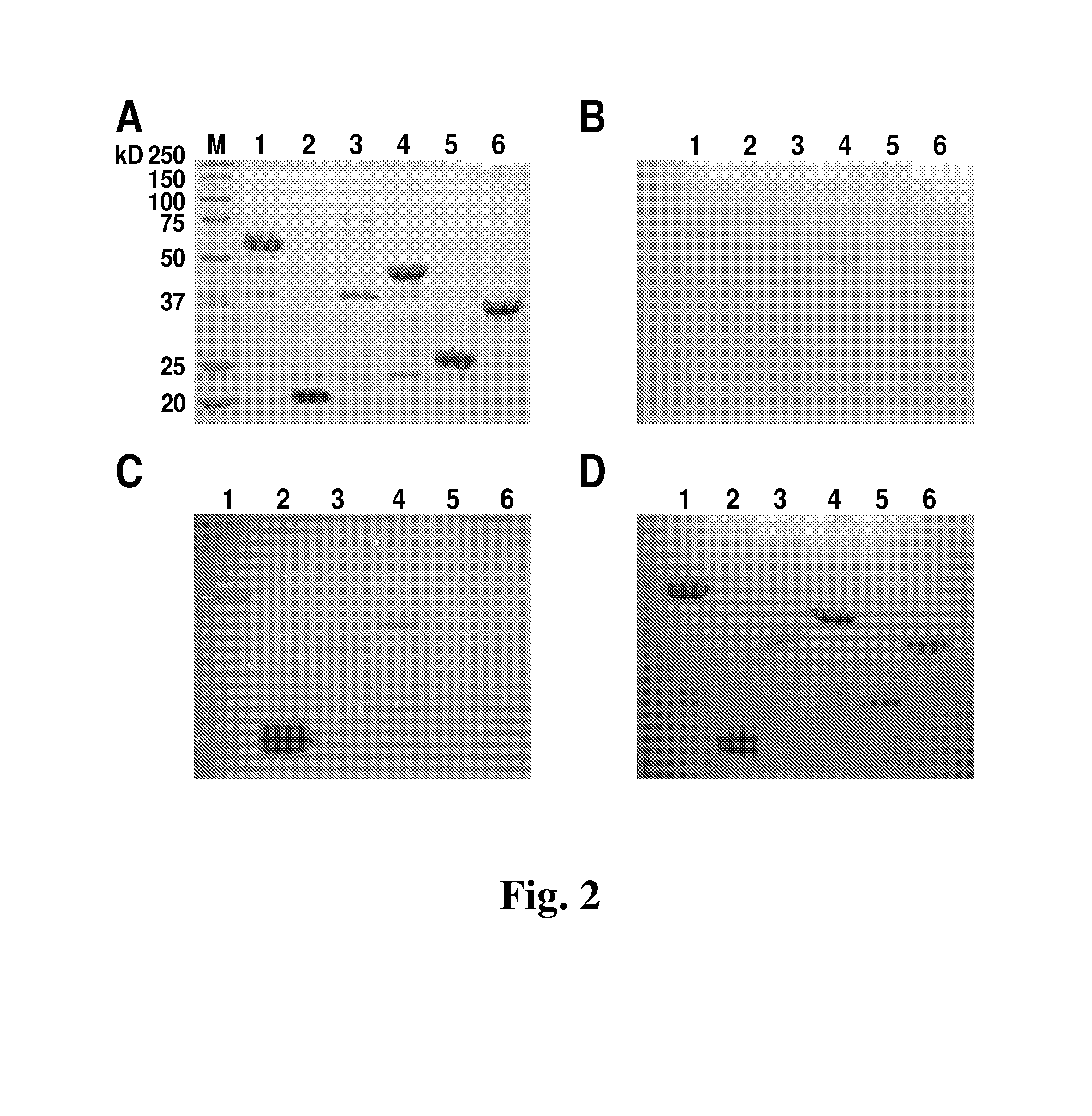Staphylococcus haemolyticus Prophage PhiSH2 Endolysin is Lytic for Staphylococcus aureus
a staphylococcus and endolysin technology, applied in the field of nucleic acid sequence, can solve the problems of posing a major threat to human health, staphylococci are persistent problems, and the conventional method of antibiotic treatment is often less than 50% effectiv
- Summary
- Abstract
- Description
- Claims
- Application Information
AI Technical Summary
Benefits of technology
Problems solved by technology
Method used
Image
Examples
example 1
Plasmids, Constructs and Strains
[0072]The Staphylococcus haemolyticus JCSC1435 lysin (GenBank Accession Number BAE05642.1) nucleotide sequence was obtained from the genomic sequence of S. haemolyticus JCSC1435 (Takeuchi et al., supra; Genbank Accession Number: NC—007168. The open reading frame was synthesized (GeneArt, Regensburg, Germany) with an E. coli-optimized codon bias and inserted into pET21a (EMD Biosciences, San Diego, Calif.) using conventional molecular techniques. The plasmid construct contains the lysin gene between the NdeI and XhoI restriction sites and encodes a C-terminally 6×His-tagged version of the protein. The truncations of the φSH2 gene were created by standard molecular biological methods. Gene fragments were amplified by PCR as previously described (Donovan and Foster-Frey. 2008. FEMS Microbiol. Lett. 287:22-33) using the full length φSH2 construct (in pET21a) as template and the primers shown in Table 1, that by design add NdeI and XhoI sites to the 5′ and...
example 2
Protein Expression, Purification and Analysis
[0075]E. coli BL21 (DE3) cultures harboring pET21a-derived expression vectors were grown to mid log phase (OD600 nm of 0.4-0.6) under ampicillin selection, chilled on ice for 30 min, induced with 1 mM IPTG, and incubated with shaking for 18 h at 19° C. For protein purification under native conditions, cells from 800 mL cultures were harvested by centrifugation, resuspended in 16 mL of Lysis Buffer (50 mM NaH2PO4, 300 mM NaCl, 10 mM imidazole, 30% glycerol, pH 8.0), sonicated on ice for 5 min (1 s pulses separated by 1 s rests), and centrifuged at 9000×g for 30 min. The cleared supernatant containing the soluble form of the target proteins was applied to 1 mL nickel-NTA-Superflow resin (QIAGEN, Valencia, Calif.) and rotated for 1 h at 4° C. The nickel matrix was packed into empty chromatography columns (QIAGEN) and washed with 20 mL of Lysis buffer, followed by 20 mL of Wash Buffer (50 mM NaH2PO4, 300 mM NaCl, 20 mM imidazole, 30% glycerol...
example 4
[0080]The turbidity reduction assay measures a decrease in optical density of a bacterial suspension due to lysis of the target bacteria by a lytic protein. The assays were performed in a 96-well dish format essentially as described previously (Donovan et al. 2006, supra). In order to reduce the variability of the assay, frozen stocks of S. aureus Newman substrate cells were prepared in a large batch as described by Becker et al. (2009b, supra). Immediately prior to the assay, the frozen cells were thawed, washed, and resuspended in the desired assay buffer such that when 100 μl of cell suspension were added to 100 μl of lysis buffer+ / −protein, the final suspension has an OD600nm of ˜1.0.
[0081]Protein constructs were assayed at a concentration of 1 μM, and the assay was performed at room temperature, measuring the OD600nm at 1 min intervals for 45 min. Buffer without enzyme served as the control. The steepest slopes of the resulting lysis curves, which corre...
PUM
| Property | Measurement | Unit |
|---|---|---|
| Length | aaaaa | aaaaa |
| Electrical resistance | aaaaa | aaaaa |
| Antimicrobial properties | aaaaa | aaaaa |
Abstract
Description
Claims
Application Information
 Login to View More
Login to View More - R&D
- Intellectual Property
- Life Sciences
- Materials
- Tech Scout
- Unparalleled Data Quality
- Higher Quality Content
- 60% Fewer Hallucinations
Browse by: Latest US Patents, China's latest patents, Technical Efficacy Thesaurus, Application Domain, Technology Topic, Popular Technical Reports.
© 2025 PatSnap. All rights reserved.Legal|Privacy policy|Modern Slavery Act Transparency Statement|Sitemap|About US| Contact US: help@patsnap.com



